This is the perfect basic or master recipe for chewy and soft oatmeal cookies. They're very easy to make in one bowl, so they come together in minutes. Bake them immediately, and have freshly baked cookies in 30 minutes. Or make the cookie dough ahead and refrigerate or freeze it for when the craving hits!
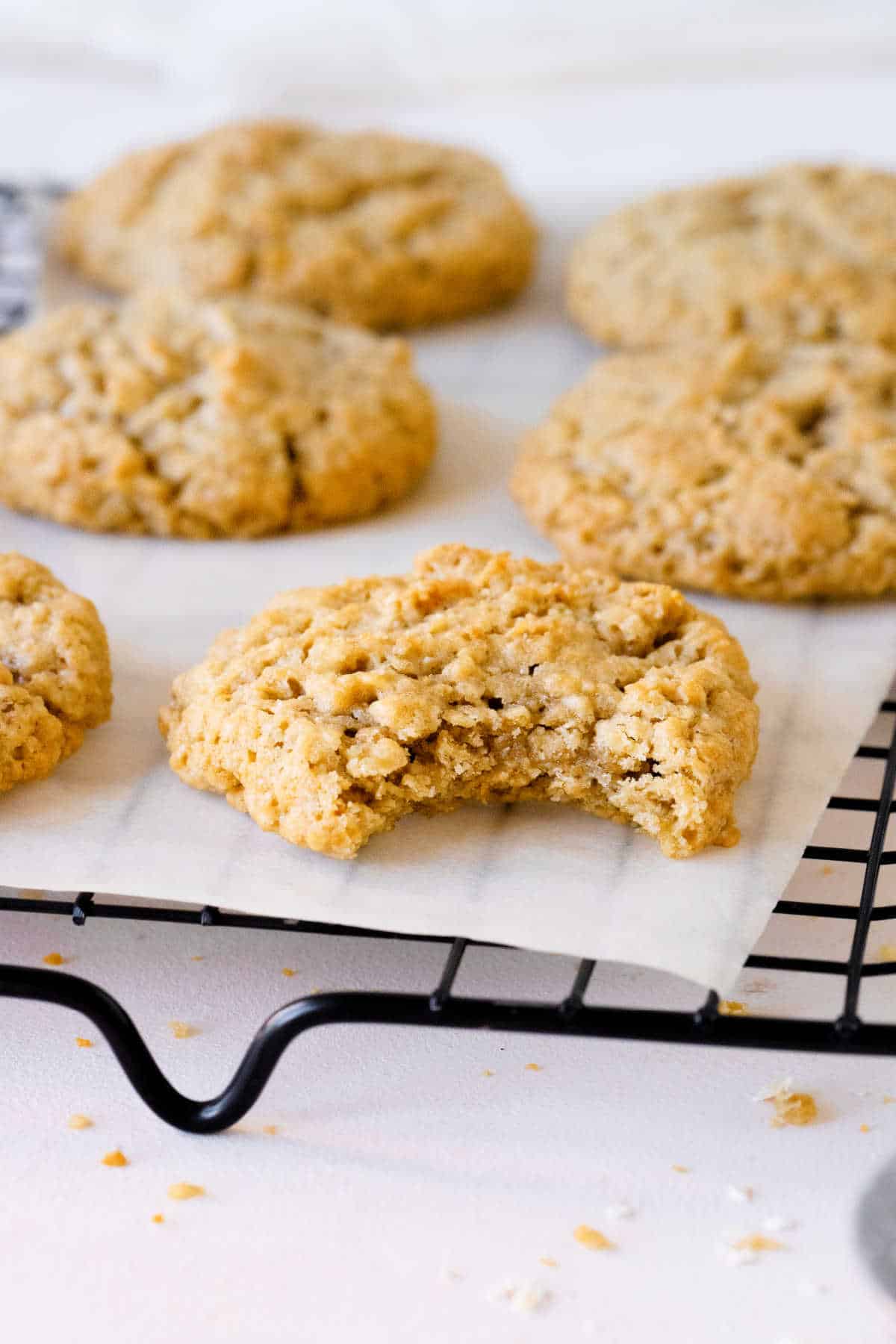
After ages of trying out different oatmeal cookie recipes, I've been using this one for years, literally twenty years or so.
For me, it's a no-fail, easy recipe. That sounds like a lot, but it delivers a chewy cookie with crispy edges that we think is the best oatmeal cookie recipe.
Starting with this base or master recipe, you can incorporate add-ins and make oatmeal chocolate chip cookies, scotchies oatmeal cookies (with butterscotch chips) and oatmeal walnut cookies (both very popular!), or nuts and take them to another level of crunchiness and flavor. We're still missing oatmeal raisin cookies in our archives, but are working on one.
It's one of our favorite cookies, especially when we slightly underbake and eat them warm. You get a sort of gooey cookie, so delicious.
If you want a similar bar-form recipe (easier to bake!), these are cousins to the fantastic carmelitas bars. It all stays in the family.
Why make this recipe
- Very easy to make: you simply mix the ingredients in one bowl. I recommend an electric mixer to make the process easier and faster, but you can make them by hand with a whisk, a large bowl, a spatula, and some arm muscle.
- Flavor: the mix of sugars and butter makes delicious cookies. They have a caramel undertone and enough sweetness to let the oat flavor shine.
- Chewy texture: if stored properly, the texture remains wonderful for a few days. The key is baking them until they are still slightly soft in the center.
- Make ahead: you can keep the cookie dough refrigerated for up to a day before baking it. Or freeze the unbaked cookie balls for up to a month and bake them directly, no need to thaw them!
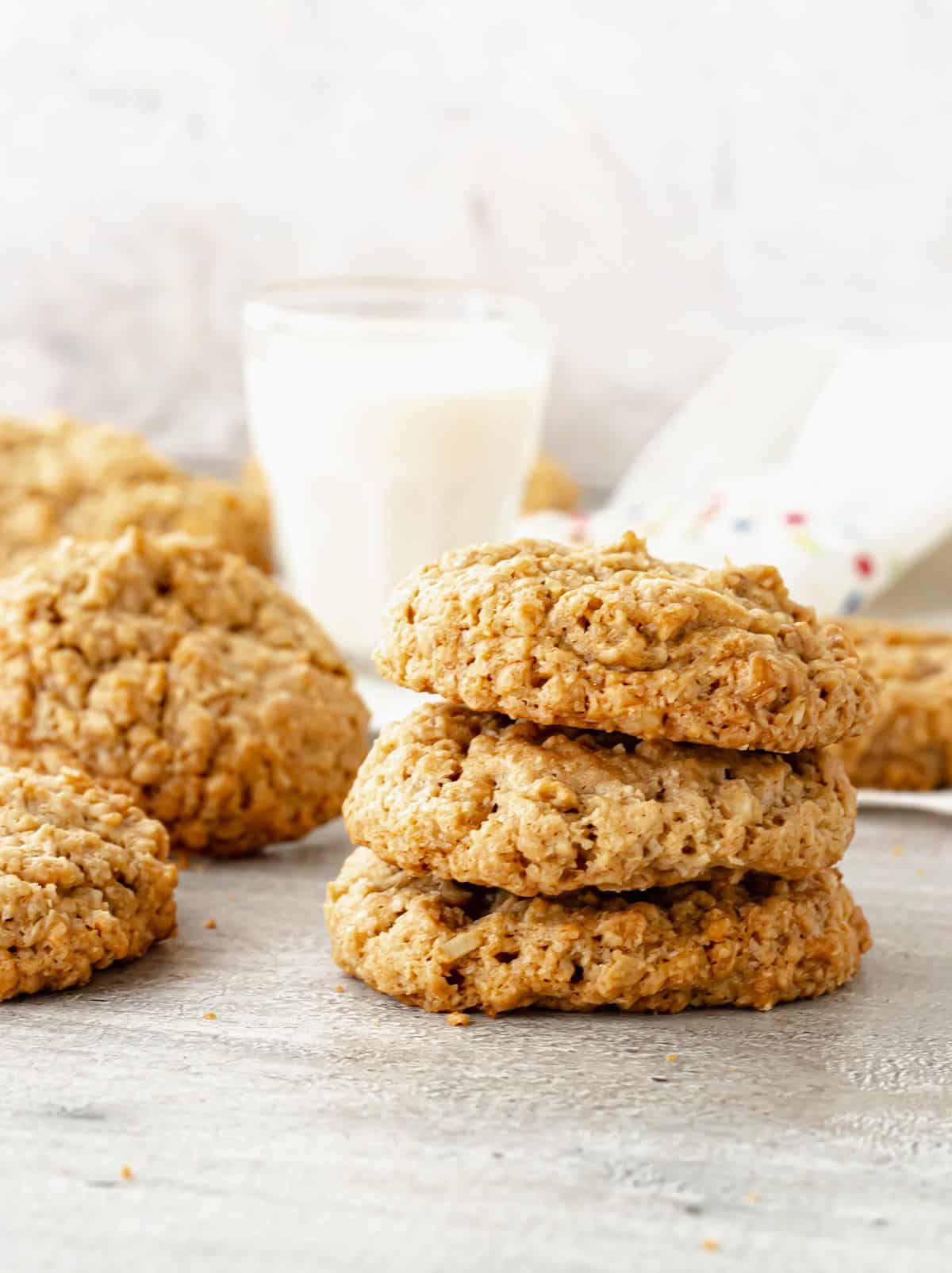
Ingredient list
- Oats: I use old-fashioned oats (traditional or rolled oats) because they have more texture, but you can use instant or quick-cooking oats.
- Unsalted butter.
- White granulated sugar.
- Light brown sugar.
- Egg: fresh, large.
- Milk: I use whole milk, but you can use low-fat or almond milk.
- All-purpose flour.
- Baking soda: make sure it's not expired.
- Vanilla: I use pure vanilla extract or pure vanilla paste when available, but a good vanilla essence (artificially flavored) also works.
- Salt: I like using kosher salt or fine sea salt when baking. But regular table salt works just fine.
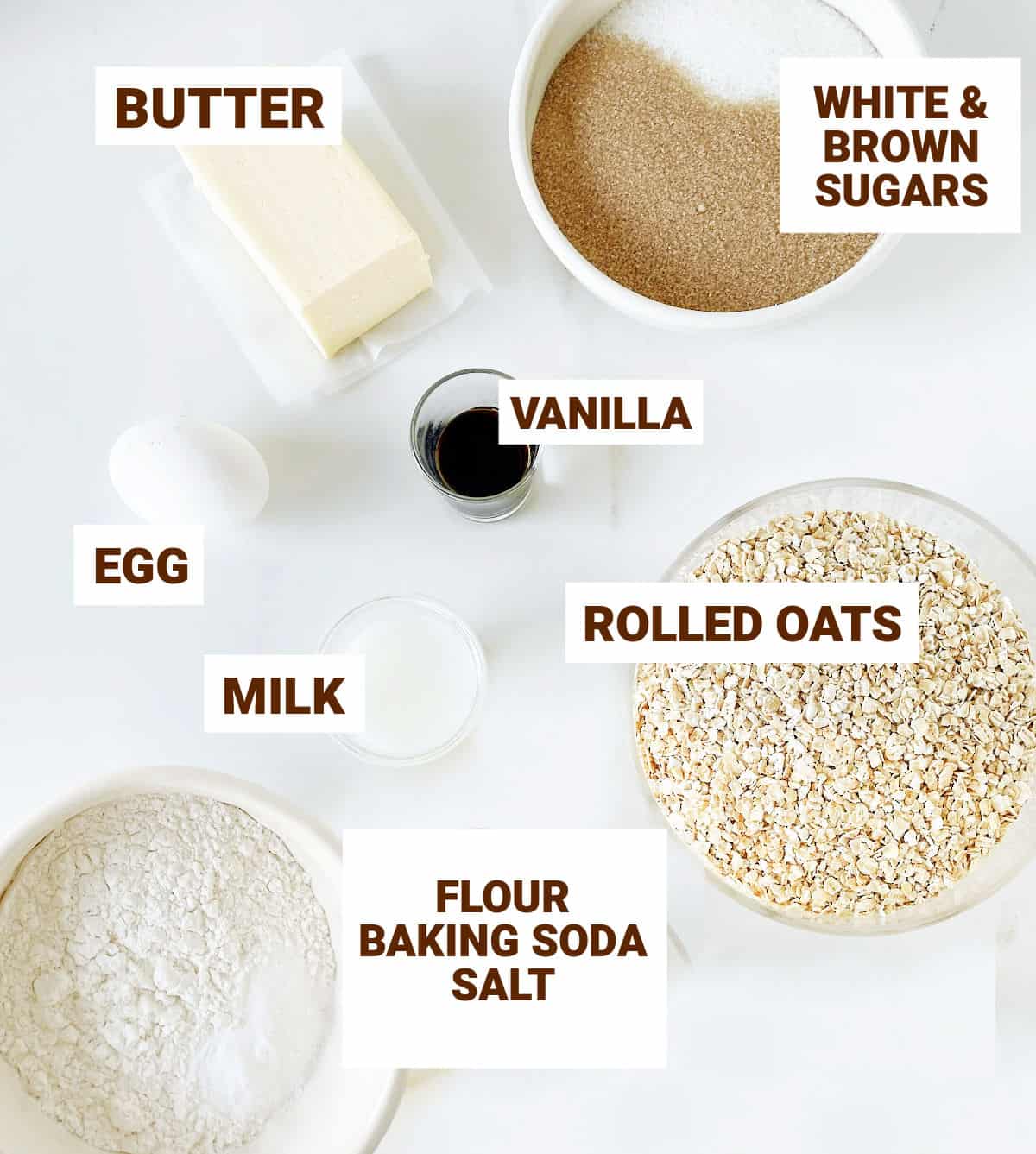
Type of oats to use
There are 2 types of oats good for making oatmeal cookies:
- Rolled oats - also called traditional or old-fashioned oats, are medium-sized and shaped like irregular discs (image below). It's the one in the box we grew up with that is used to make porridge, the best granola recipe, and oatmeal muffins. This is the most commonly used oat and a sure way to get good results.
- Instant oats - also known as quick oats, are more processed than the ones above. I find that they lack enough texture, but you can use them, of course.
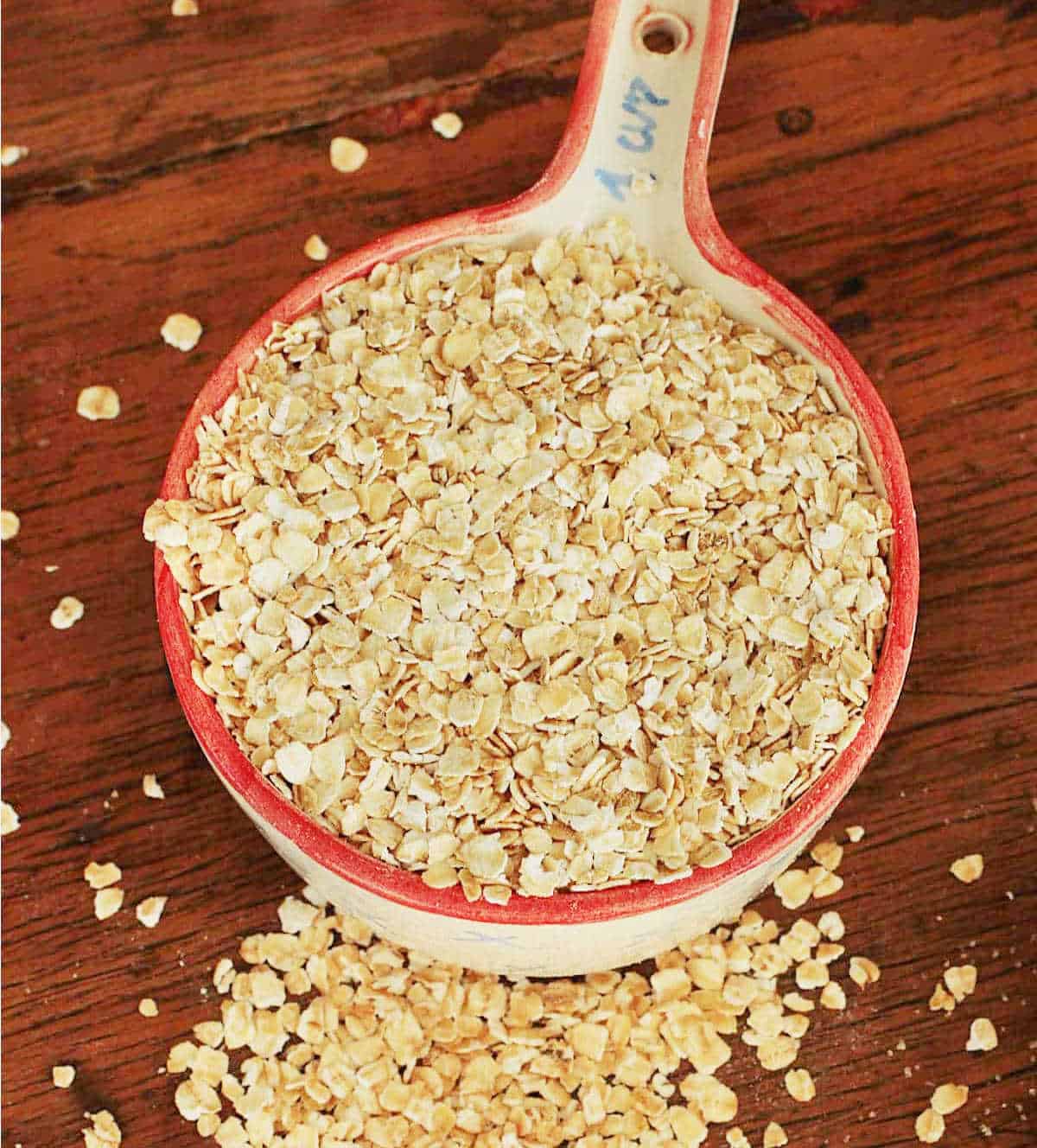
One of my favorite things about this oatmeal cookie recipe is that the base mixture (similar to chocolate chip cookies) is super simple to make.
- Mixers: using an electric or stand mixer with the paddle attachment will make this process much easier. The cookie dough must be mixed for several minutes at the beginning, which is harder to do by hand.
- Creaming: the butter must be soft (but not greasy or starting to melt) so that it's well mixed with the sugar until very creamy. Add the sugars gradually to incorporate better, especially if using a handheld electric mixer.
- Adding the egg: don't overlook this step and take the time to beat it for several minutes. It will help the cookies' texture and shape. The dough should be soft and creamy, as shown in the first image below. After this step, add the rest of the wet ingredients, milk, and vanilla.
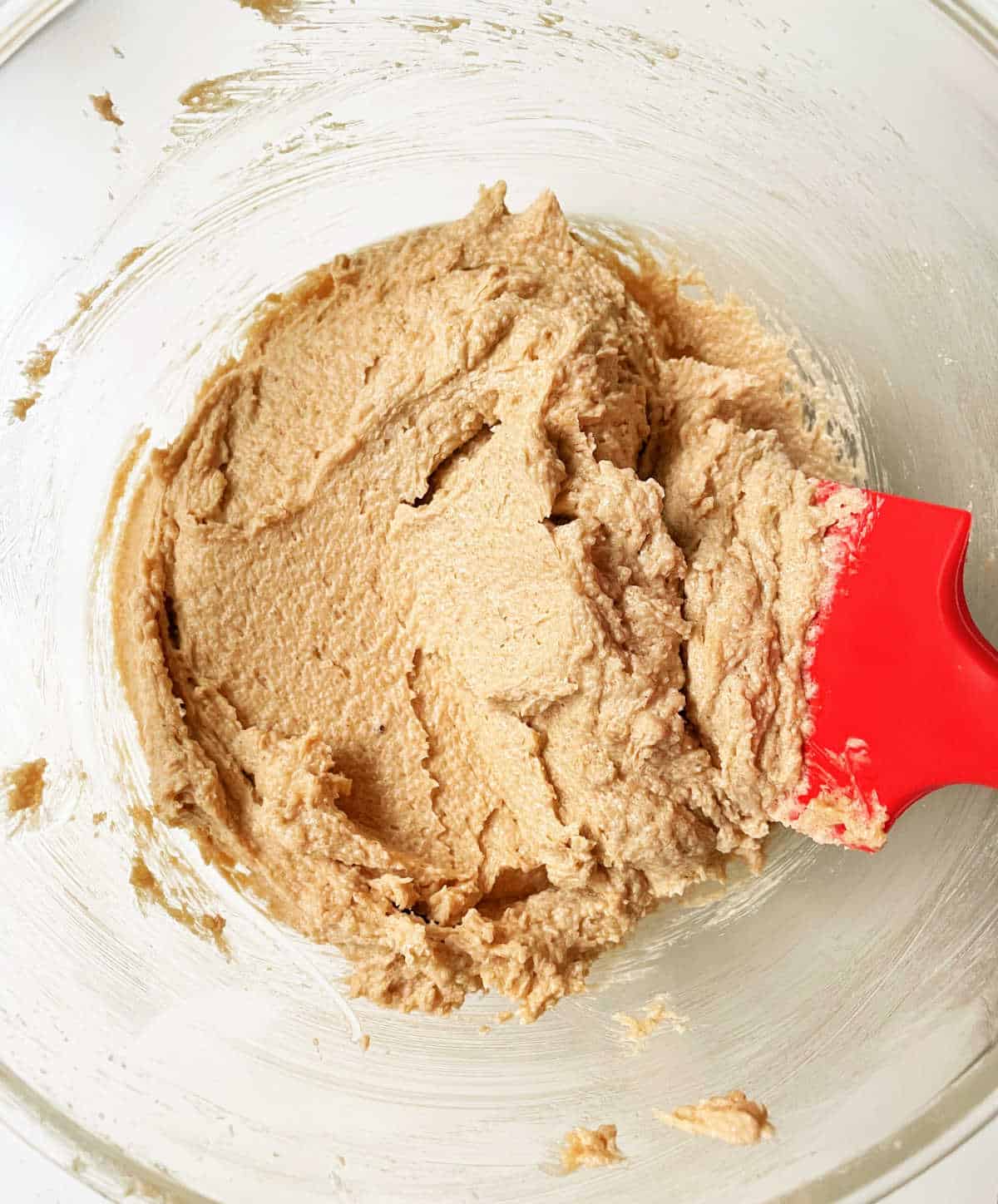
Adding the flour mixture
Also called dry ingredients, should be sifted before adding.
This is especially important with baking soda as it can clump during storage and not dissolve during baking.
Add them at low speed and mix until well incorporated, but no more. We don't want to develop the gluten in the flour as it will render tougher cookies.
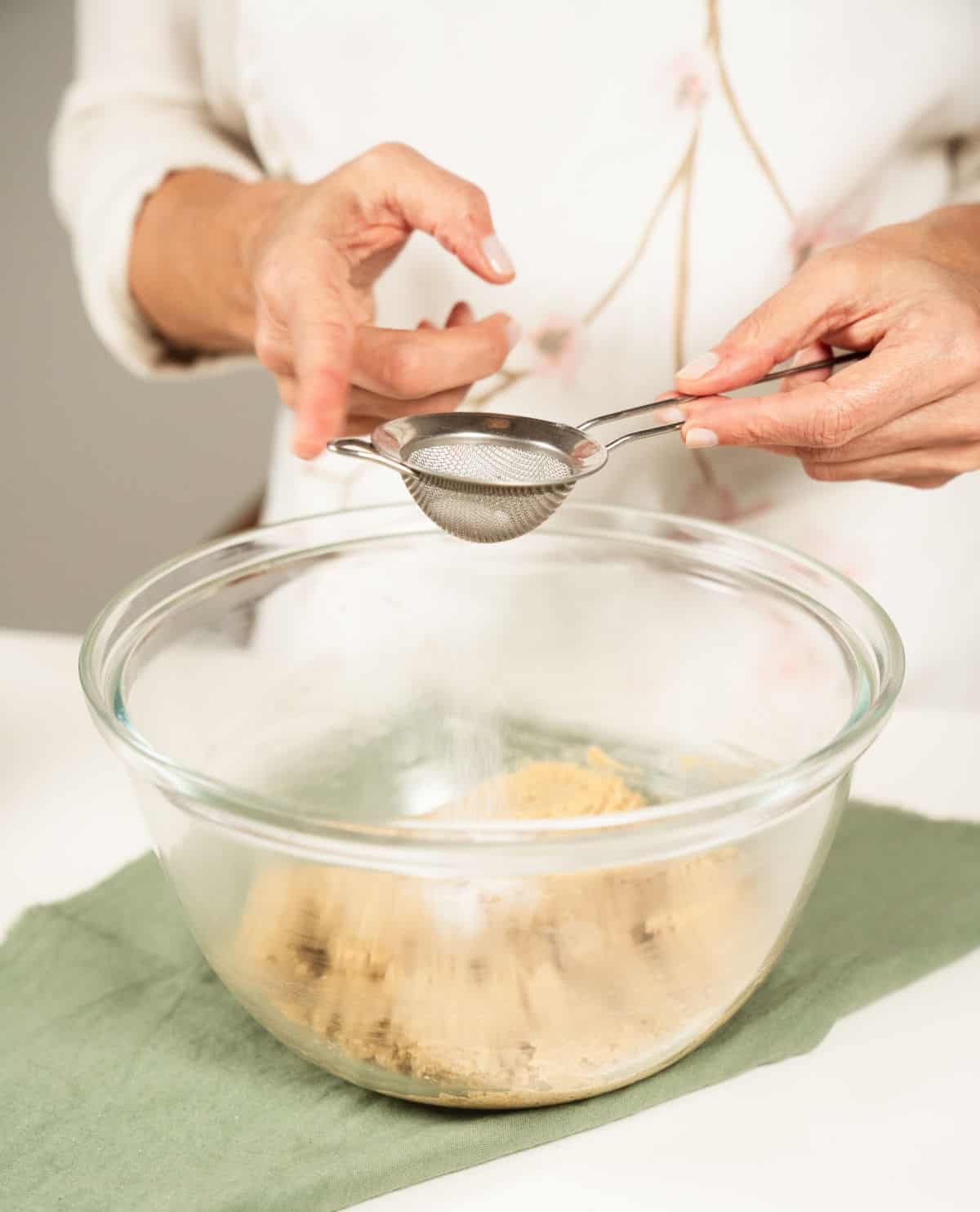
Baking
- Preheated oven: ensure it's at the right temperature when you put in the cookies.
- Cookie sheets: I recommend turning the baking pan around (back to front) halfway through baking, so the cookies bake better. I found this the easiest way to bake them as evenly as possible, especially when using a large baking sheet.
- Preparing the pan: after years of baking homemade cookies, lightly buttering the pan is my first choice. It works well for me. But you can use parchment paper, a silicone mat, or another type of lining.
- How long you should bake them depends on the texture you want. I like chewy cookies with crisp edges, so I underbake them a tiny bit and take them out when the center is still very soft. For crunchier cookies, bake them for a few more minutes, depending on the size. Do a test run: bake a few cookies first, and find your sweet spot regarding baking time and texture.
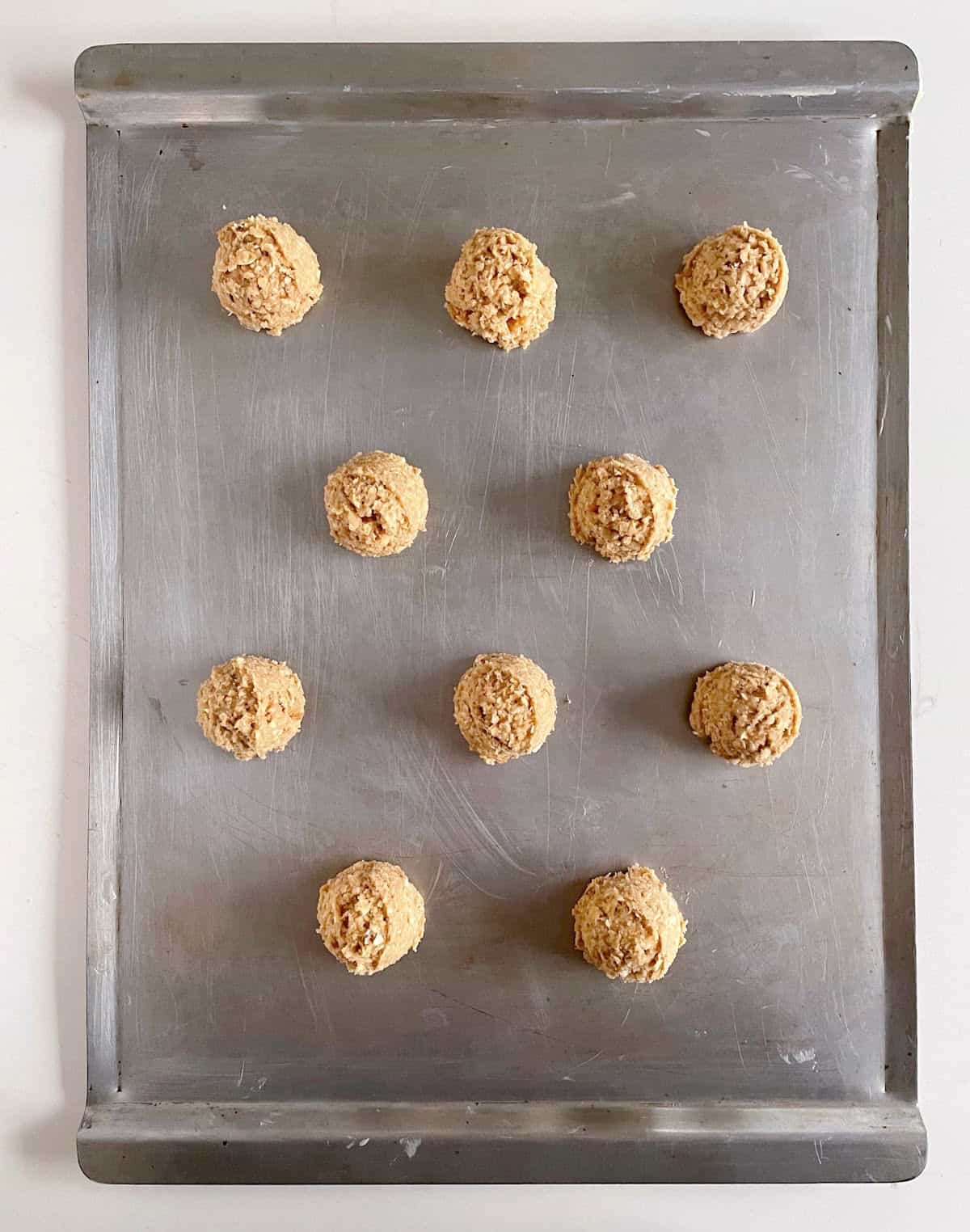
The way to make a large batch and have freshly baked cookies any time you want is to freeze them individually.
It takes 3 simple steps:
- Measure and freeze: pretend you're about to bake them, measure them (with a cookie scoop), and place them on a cookie sheet, no need to leave much space between them. Pop the cookie sheet into the freezer.
- Transfer to a bag: once the raw cookie balls are frozen rock solid, transfer them to a plastic bag or freezer container. That way, you won't have the cookie sheet stuck in the freezer until you decide to bake.
- Bake straight from the freezer: when you want fresh oatmeal walnut cookies, take the number of frozen cookie balls you want to bake, place them on a cookie sheet, and bake them as directed in the recipe below. They might take an extra minute or two due to their freezing temperature when you put them in the oven.
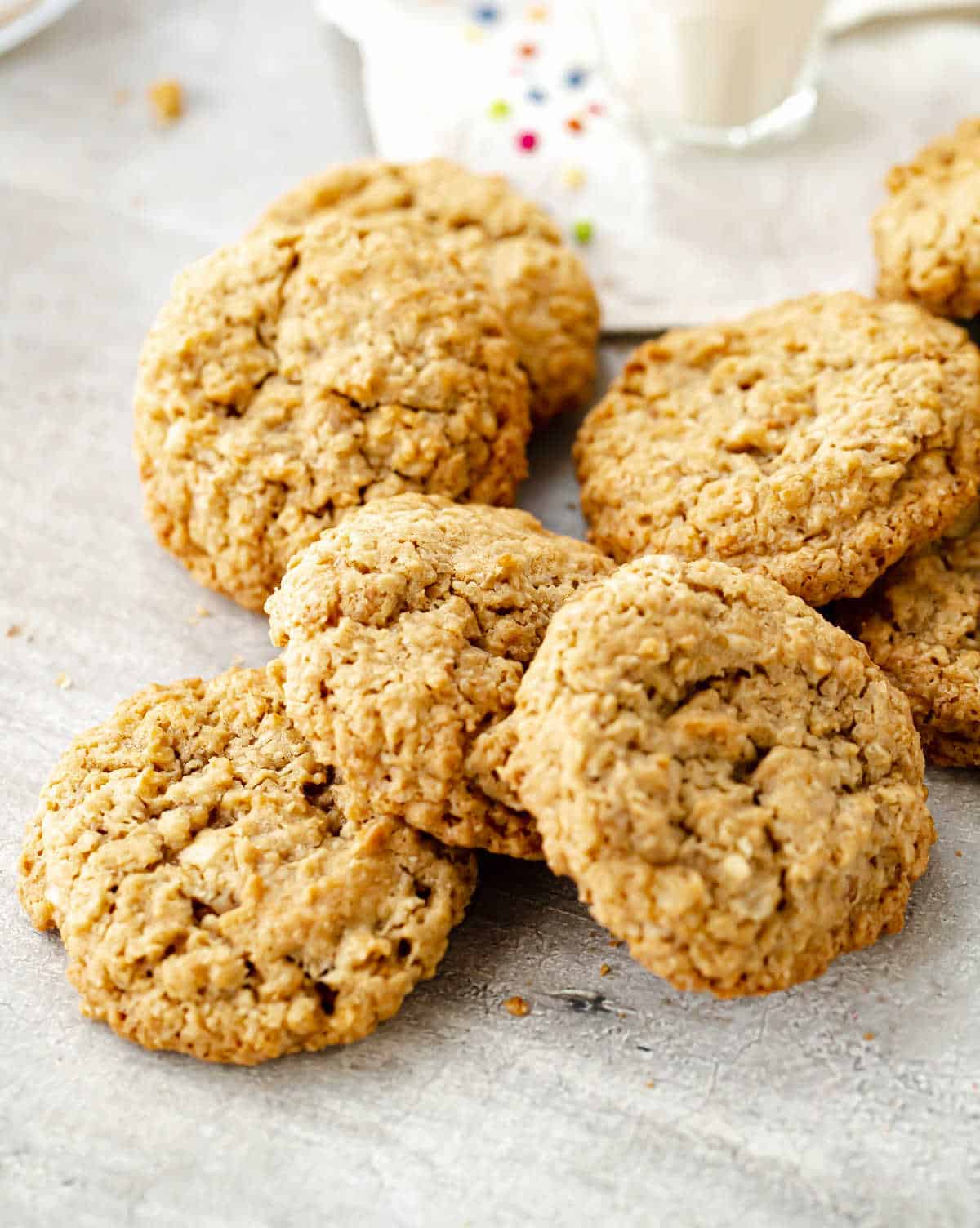
Kitchen notes
- Organization: read the recipe first and ensure you have ingredients at the correct temperature, equipment, and enough workspace. This will make the process so much easier.
- Baking time: keep in mind that all ovens and pans are different, even if they look the same or very similar. The baking time in my recipes is as accurate as it can be, but it might take you more or less time. You can use a thermometer(like the OXO oven thermometer) to check that your oven is at the right temperature. I recommend you keep track of how your oven works and what tiny details you might need to adjust.
- Refrigerating the dough: I don't chill it, I bake the cookies directly, and the texture is fantastic. But the type of oats you use might differ from mine as they can vary depending on what part of the world you live in and what brand you buy. You should not have issues using quick-cooking oats because they hydrate quickly. I recommend you test-bake a few cookies first and see how they come out, no matter what type of oats you use or if you refrigerate the dough first.
- Measuring the cookies: use a cookie scoop so your cookies bake evenly. Leave roughly a 1 or 2-inch separation between each (depending on the size), so they can spread comfortably during baking. I use the small cookie scoop of this set that's 1.57 inches / 4cm in diameter for regular-sized cookies.
Test run: I always recommend baking two or three cookies first and checking the baking time to ensure you don't over or underbake them. - Batching and freezing: Make a large batch (double this recipe, for example) and freeze them. It will save time and produce freshly baked oatmeal cookies.
- Storing: cookie jars or tins are ideal for keeping any cookie. But plastic bags can work well too.
- Flavorings: boost the flavor of these cookies by adding ground nutmeg, orange zest, or a tablespoon of Frangelico or some other nut liqueur. If you like a sweeter cookie, substitute half the dark chocolate chips for milk chocolate chips or white chocolate chips. For soft cookies with a hint of molasses, use dark brown sugar.

- Run out of granola? Crumble a few of these over your bowl of yogurt and fruit.
- Want to play around with your crumble recipes? Omit the milk in the recipe and use this cookie dough as a topping for apple crumb bars, raspberry apple bars, or cherry crumble.
- Make sandwich cookies: if you make small-sized cookies, you can fill them with dulce de leche and have awesome alfajores cookies.
Related recipes you might like:
If you made this recipe and loved it, you can comment below and leave a 5-star ⭐️ review. Also, if you had issues, let me know so we can troubleshoot together.
You can also subscribe to our FREE email series 'Baking the Best' and our regular newsletter. Or follow and save my recipes on Pinterest.
As an Amazon Associate, I earn from qualifying purchases. Read my disclosure policy.
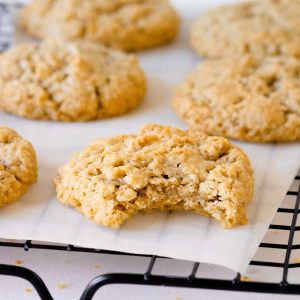
Soft and Chewy Oatmeal Cookies
Ingredients
- ¾ cup unsalted butter, at room temperature
- 1 cup light brown sugar
- ½ cup white sugar
- 1 egg, at room temperature
- 2 tablespoons whole milk, at room temperature
- 1 teaspoon vanilla extract or paste
- 1 ¼ cups all-purpose flour
- ½ teaspoon baking soda
- ¼ teaspoon salt
- 3 cups old-fashioned rolled oats
Instructions
- Preheat the oven to 350°F (180°C).
- Lightly grease cookie sheets or line with parchment paper.
- Beat ¾ cup unsalted butter in a large mixing bowl until smooth, about 20 seconds. Gradually add 1 cup light brown sugar and ½ cup white sugar and beat for 2 minutes, until creamy, scraping the sides of the bowl as needed.
- Add 1 egg and beat at medium speed for 3 minutes, scraping the sides of the bowl a few times. Add 2 tablespoons whole milk and 1 teaspoon vanilla extract or paste, mix until well incorporated.
- Add 1 ¼ cups all-purpose flour, ½ teaspoon baking soda (sifted to avoid lumps), and ¼ teaspoon salt to the butter mixture. Mix at low speed until well blended, and no dry spots remain. But don't overbeat at this point.
- Mix 3 cups old-fashioned rolled oats in two parts, so they're easier to incorporate. I use a rubber spatula for this part. Make sure no flour remains in the bottom of the bowl. At this point, the cookie dough can be refrigerated for up to a day. See note below.
- Scoop out portions onto the prepared baking sheet, leaving space between them, an inch or two depending on the size of the cookie. If making larger cookies I flatten them slightly with my fingers tips so there's less chance of the center taking too long to bake and the sides being too brown.
- Bake for 10-12 minutes, depending on the size, until golden brown and still soft in the center. I use a 1.5-inch cookie scoop and bake them for exactly 10 minutes.
- Smack the pan on the counter immediately after you take it out of the oven. It will deflate the cookies a little and help with the texture.
- Let cool on a wire rack before lifting them carefully from the paper and cooling them completely.
- Once they cooled down completely, transfer the cookies to jars or an airtight container.
Notes
Test run: I always recommend baking two or three cookies first and checking the baking time to ensure you don't over or underbake them. Baking: underbake them a tiny bit when the center is still very soft, and they will be chewier. If you want crunchier cookies, bake them for a few minutes more, depending on the size. You can do a test run, bake a few cookies first, and find your sweet spot regarding baking time and texture. Batching and freezing: make a large batch (double or triple this recipe) and freeze them. It will save you time, and you'll always have freshly baked oatmeal cookies. Keeping: cookie jars or cookie tins are ideal for keeping them. But plastic bags or airtight plastic containers work well too.

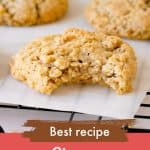
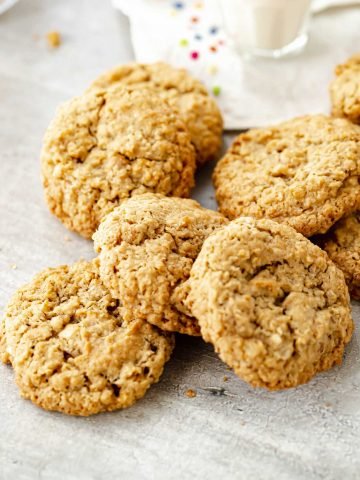
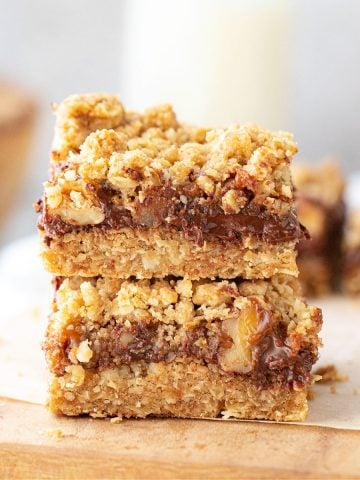
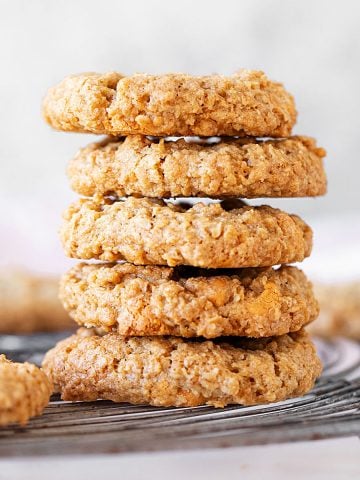
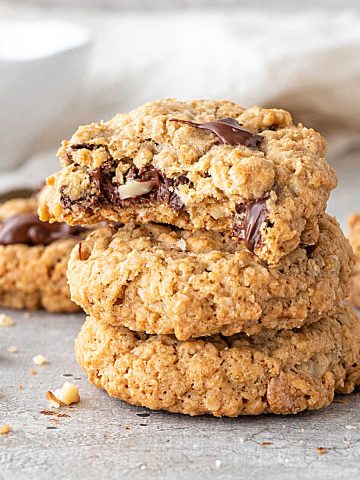
Bonita Nickelson says
I love a soft and chewy oatmeal cookie! I will definitely try your recipe. If I wanted to add walnuts how much do you think? 1 cup?? Thanks for sharing!
Paula Montenegro says
Hi Bonita! You can add from 1/2 to 3/4 cup of coarsely chopped walnuts. There is also an oat walnut cookie recipe you can check out.
Donald says
Why isn't there any cinnamon in this formula?
Paula Montenegro says
You can add some if you want to Donald.
DORA says
Excellent recipe for anyone to follow.
Pat says
The perfect oatmeal cookie
Wanda says
Can I add raisins?
If yes then how much would you say is a good amount?
Paula Montenegro says
Yes Wanda, you can! I'd say 1 cup raisins for a plump, sweet cookie.
Barbara Sylvester says
Thank you for this recipe, baking them now. YUMMY
Rehana says
Amazing recipe.
Paula Montenegro says
Thank you!
Judy Moyer says
Excellent cookies. I made them exactly as recipe state's. Delicious without raisins and nuts, do not care for either one. Crunchy edges with soft center. Gives you about 5 dozen, enjoy...